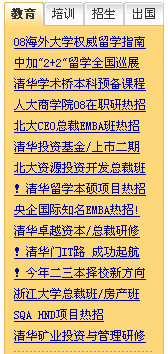Home >Web Front-end >HTML Tutorial >HTML Tutorial: Definition List_HTML/Xhtml_Web Page Production
HTML Tutorial: Definition List_HTML/Xhtml_Web Page Production
- WBOYWBOYWBOYWBOYWBOYWBOYWBOYWBOYWBOYWBOYWBOYWBOYWBOriginal
- 2016-05-16 16:46:071622browse
Original text: http://andymao.com/andy/post/104.html
Previous section: Ordered list
After writing "Unordered List" and "Ordered List", someone has told me that these two articles are not interesting. If these two articles are only read in one-way reading, then it is indeed meaningless, but the important thing about these two articles is that they require readers to add their own thinking. Ordered and unordered single tags are very simple, as long as you know how to use them, but I think the key point is not to know what the tag looks like, the key point is to know what kind of list is suitable for what kind of data. What kind of data is ordered and what kind of data is unordered? Think after reading, so that you can learn something and the knowledge can be your own.
Definition lists have a special form and usage. Compared with unordered lists, definition lists are used much less often. There are also many friends who have not started using this list, so let’s break down the code of this list:
Looking at the above code, we find that the
- Ordered list
- Ordered list
- Ordered list
- Ordered list
The above is obviously inappropriate. This form is an unordered list. Why use a definition list? It doesn’t make sense semantically.
- Ordered list
- An ordered list is a data form in which sequenced data is organized in a list
- Ordered list
- An ordered list is a data form in which sequenced data is organized into a list
- There is no explanation for this sentence
- Ordered list
- Ordered list is a data form in which sequenced data is organized into a list
I personally think the above form is feasible. So can one DT carry multiple DDs? I have also found no literature stating that this is not possible, and there are still many examples of one DT with multiple DDs on some well-known websites. My opinion on this is that under special circumstances it is okay to have one DT with multiple DDs, but in general I think this approach is still lacking. From an interpretation point of view, do multiple DDs indicate multiple interpretations? Or the explanation should be divided into paragraphs, and there is no need to let DD be the dog that catches the mouse. Many paragraph tags can be embedded in a DD. Furthermore, from the perspective of style application, multiple DDs are loose as a whole and their design is not scalable enough. For example, when we want to create the effect of clicking DT to hide the corresponding DD, this multi-DD approach is not so easy to implement. Therefore, if it is not for special purposes, try not to use one DT with multiple DDs. Instead, put the content in the DD. For segmentation, use paragraph tags. For segmentation, use ordered or unordered lists. To perform.
Let’s talk about it from the beginning. The label itself is nothing. The important thing is to think about how to apply it. Here is a picture for you to see whether you should use a custom list. Let’s discuss it together.

Statement:
The content of this article is voluntarily contributed by netizens, and the copyright belongs to the original author. This site does not assume corresponding legal responsibility. If you find any content suspected of plagiarism or infringement, please contact admin@php.cn

